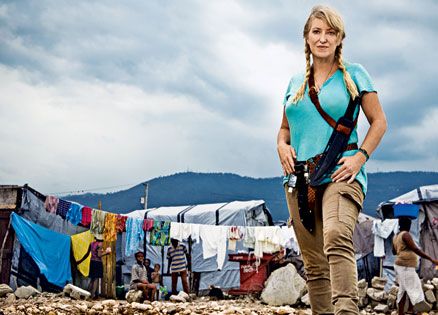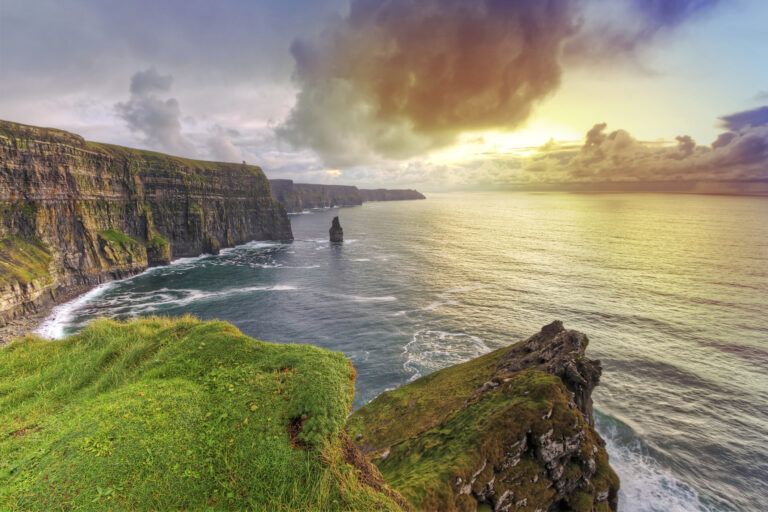That morning I zoomed through another set of red lights on my Rollerblades, heading downtown in Manhattan. I had a pretty hefty first-aid kit and a small bottle of perfume in my backpack.
People streamed toward me, disoriented, their hair and clothes covered in soot, holding cell phones, trying to get a signal. I pushed forward. Soon I was alone in a blizzard of ash. The ground rumbled, and I dove under a UPS truck for cover.
The second tower of the World Trade Center had just collapsed.
I grew up in Australia, my dad a preacher, my mum a nurse. I had been a nurse’s aide at Mum’s hospital in my teens. More recently in New York I’d been a freelance filmmaker. That day, September 11, 2001, I skated downtown, thinking that I could help somehow.
Without really knowing it, I had also skated into a new role: passionate volunteer.
In the sooty darkness I said a prayer asking God for strength. I darted out from under the UPS truck. I took a whiff of perfume to ward off the stench of smoke then made my way into a store and commandeered a pair of flip-flops from a dazed employee. “I need those,” I said.
Like other volunteers, I started going through the rubble, searching for survivors, but I quickly realized that I wasn’t as well-equipped as the firefighters and ironworkers. Eventually I partnered with an EMT named Mike.
The people who really needed our help were the rescue workers themselves. At the very least we could clean their eyes of dust and ash.
We set up shop in an abandoned bar called St. Charlie’s. We spray-painted a sign out front that read, “Ground Zero First Aid Station.” Our job was to do all we could for those on the front lines in the smoldering rubble.
I remember the firemen bringing us an ironworker who was crazed with exhaustion. He didn’t want to stop working but he could barely stand up. I held his hand and smoothed his hair until he finally fell into a gentle sleep. I wasn’t a doctor or nurse, but this was what I could give, that touch of love necessary in a crisis.
That’s what volunteering is about. Giving your love in a place that desperately needs it. I learned at Ground Zero that I had skills I never knew I had, skills that could make a difference. I could organize, give hugs, pass out water, bandage wounds, clean faces, hold hands, bring hope, pray.
I’m not rich, I’m not affiliated with a big organization, but volunteering has become my full-time job. More than that, it’s my calling. It has changed my life. The beauty of it is that anyone can do it.
Here are the five places in the world that need your help the most. Some you can visit, some are too dangerous for most volunteers. But there’s always something you can do.
Sri Lanka. I was still working in film at Christmastime in 2004 when the massive tsunami devastated parts of Asia. I was glued to the TV news. This wasn’t a place I could skate to, but I yearned to help.
At one point Anderson Cooper was reporting from a pile of rubble and something inside me clicked. I’m going there.
Just so you know how unlikely this was, my boyfriend and I were flat broke. “We’ll borrow frequent-flier miles from our friends,” I said. “We’ll see if anybody we know can donate medical supplies.”
My experience at Ground Zero had taught me that when you’re meant to do something, the whole universe can open up to lend a hand.
We got tickets, medical supplies, cash donations. Even the nurse giving us our vaccinations passed along some free antibiotics and diarrhea pills. We flew to Colombo, Sri Lanka, met up with some other volunteers, packed a van with water and food and headed to the devastated coast.
We stopped in a village. Starving people sat everywhere, listless. Ten days since the tsunami and there was no sign of any aid. Nothing. Children swarmed around us, begging for just a sip from my water bottle. God, I prayed, send every spare angel to this hurt place.
I planned to be in Sri Lanka for a couple of weeks. I stayed in that village for 14 months.
Volunteering is very practical: You do what you can with the tools you’ve been given. More volunteers poured into Sri Lanka. Together we organized a makeshift hospital and an open-air soup kitchen.
We cleaned the wells so there would be fresh water. We buried the dead. We played with the children. I’d brought colored pencils and paper and they drew. One day I took the kids back to the beach to help them deal with their fears of the ocean.
It sounds like so little. It is so much. Sri Lanka is still very poor. Some of the infrastructure has been rebuilt, but it will take years for the country to fully recover. The one legacy I’m proudest of in the village is a tsunami early-warning system.
In a small office, people search for news on the Internet. An alarm can be relayed through sirens and loudspeakers. The villagers now have a simple system to alert them to danger, the Community Tsunami Early-Warning Center.
Somalia. The drought in the horn of Africa has affected more than 13 million people. Addressing it has become complicated because of the political situation.
I know volunteers who’ve worked in the refugee camps in Somalia and across the border in Kenya and Ethiopia, but recently most organizations were forced out of the drought-ridden areas. Work in such places can be dangerous.
Still, some aid groups have managed to provide tents, food, seeds for crops, blankets, mattresses, utensils. The U.S. government supplies 53 percent of the global relief aid to this region. The problem is so immense that government partnership is essential.
There are several good organizations you can give to, including World Vision, Doctors Without Borders and Aid Still Required. And please send your prayers.
Zimbabwe. HIV/AIDS is a peril in much of Africa and it’s heartbreaking to see how it affects the children. The problems can be so overwhelming, but as a volunteer you learn to focus on the little things that you can do.
Pam Kidd, an American real-estate agent and minister’s wife, was visiting the capital city of Harare in Zimbabwe. There, she met a woman who gave out bread and tea to homeless children with AIDS. It was such a simple way to give them nourishment and love.
How can I help? Pam wondered. After all, she lived across the world in Tennessee.
She went back home and raised money at her church to build a compound for the tea lady. If we could only find a safe place for these children outside of the city, she thought. On another trip to Zimbabwe she met a cab driver named Paddington who had a similar vision.
Together they formed an organization called Children of Zimbabwe and raised enough money to buy a farm where the kids could live. They’ve since started a lunch program at the local school and seed distribution for the nearby farmers, even built a playground.
“It’s just a drop in the ocean,” says Pam.
But those drops add up. There is always a way for you to add to that sea of human compassion.
Haiti. Right after the quake hit Haiti in 2010 I flew down with a group and we set up an outdoor hospital on a former golf course. Soon we were treating 1,000 people a day.
There's still so much to be done in Haiti. I figure if we can make a difference there in the poorest place in the Western Hemisphere, we can make a difference anywhere. You can help by visiting weadvance.org.
I used to think that Twitter and Facebook were a big waste of time, but in Haiti I saw how social media helps. When we needed something, whether it’s more doctors, supplies, volunteers or prayers, I posted the request on Facebook. Our friends responded.
Once I even had to use Twitter to rescue me. I woke up in my tent one morning so sick I couldn’t get out of bed. I cried out, but no one could hear me. Finally I tweeted from my bed. A woman from the next tent came rushing in.
The Haitian people’s profound faith continues to inspire me. That first night, only days after the earthquake, I heard singing wafting through the bushes and trees. When I sought out the voices, I discovered they came from the hungry lining up for food. They sang hymns praising God.
Many times I joined them at an open-air church. I closed my eyes and lifted my hands skyward, like them, asking for God’s love to engulf us and heal us. It is still my prayer for the people of Haiti.
Your own town. There are needs in every community, and we all have something to give. You can read to a child, knit a shawl, serve a meal, plant a tree, rake a yard, send a card, make a phone call.
My first experience as a volunteer came when I was just a girl visiting the elderly in the hospital my mother ran in Australia. I loved those people. I danced for them, painted their nails and brushed their hair. I would lay my head in their laps and listen to their stories.
Just listening to a lonely person can make their day. Anyone anywhere can do that.
Sometimes the world seems like a dark place, but upon closer inspection, I see millions of shining lights. We can all be one of those shining lights. Far away and close to home. We are meant to give; we are meant to help.
|
|





